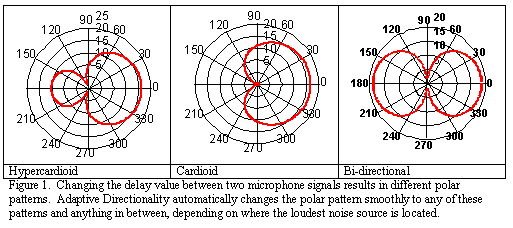Question
What is the difference between Fixed Directionality and Adaptive (Flexible) Directionality?
Answer
Regarding fixed directionality, the professional has a choice of three different fixed polar patterns (hypercardioid, cardioid, or bi-directional) or back to omni, depending on the needs of the patient (see Figure 1 for a graphic representation of free field polar plots). Programming the device with a particular fixed polar pattern will electronically fix the delay time and the result is the chosen pattern. However, a fixed polar pattern may not be ideal for all noisy situations.
In real life, noise is typically not static and changes location constantly. In order to provide the optimal directional pattern at all times, an adaptive directionality algorithm can be used. This algorithm constantly monitors the environment and can change the direction of the null in the polar at a rate of 250 times per second. This advanced technique has two essential elements. The first element is determining what is coming from the front and what is coming from the sides or behind (or anywhere in between). To understand what is coming from the front, the algorithm analyzes the output of each microphone with respect to the front microphone. The same analysis is completed with respect to what is coming from the back microphone. Then an adaptive filter is used to maximize the noise cancellation by automatically changing the filter coefficients according to a noise-minimization algorithm. The result is placing the null of the microphone sensitivity at the location of the loudest noise source originating from the side or rear hemispheres, at a very fast rate. Since the polar pattern is changing as often as 250 times per second, only an automated graphic representation could show this changing pattern with the null ranging anywhere from 90° to 270° depending on the noise source. 
Flexible directionality is achieved in the Canta product line by utilizing two omni directional microphones. The two microphones have separate A/D converters to enable their signals to be independently converted into digital signals. An active microphone matching filter is then used to match the frequency response of each microphone and ensures that the microphones remain matched over time. It is essential for any dual microphone directional algorithm to have matching microphones for accurate directionality to take place. Then, depending on the needs of the patient, the Canta can be programmed with an adaptive directionality algorithm or with a fixed directional algorithm, or BOTH.
Bio.
Laurel Olson is a research audiologist with the GN ReSound North America Research Audiology Group. Ms. Olson is based in Chicago and is responsible for the US external research activities along with some development areas. Ms. Olson joined ReSound in 1994 in the audiology research group. Before joining GN ReSound, she was a dispensing audiologist for 7 years at a private practice in Arizona. During that time she also worked for NAL in Australia for about 6 months. Ms. Olson has a master's degree in audiology, obtained in 1987 from Northern Illinois University.
